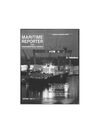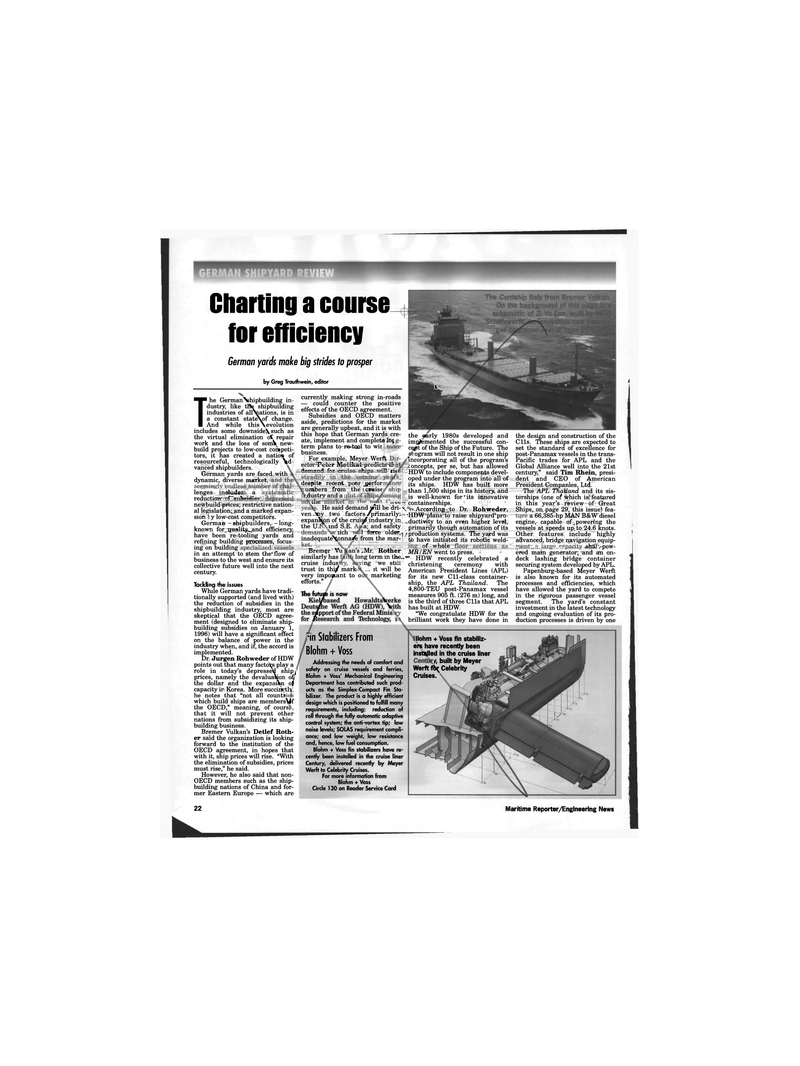
Page 20: of Maritime Reporter Magazine (December 1995)
Read this page in Pdf, Flash or Html5 edition of December 1995 Maritime Reporter Magazine
Charting a course for efficiency
German yards make big strides to prosper by Greg Trauthwein, editor
L
The German"Vhipbuilding in dustry, like tfte shipbuilding industries of allVations, is in a constant stat^of change. And while this \e volution includes some downside\such as the virtual elimination o£ repair work and the loss of somV new- build projects to low-cost conrpeti- tors, it has created a natios of resourceful, technologically \d vanced shipbuilders.
German yards are faced with dynamic, diverse market, currently making strong in-roads — could counter the positive effects of the OECD agreement.
Subsidies and OECD matters aside, predictions for the market are generally upbeat, and it is with this hope that German yards cre- ate, implement and complete l6| term plans to re~taol to wir business.
For example, Meyer Werft ector Peter Motikat predicts tfi demand for cruise ships will ris lenges includes: a reduction of subsidies; newbuild prices; restrictive nation- despite recent poor perfor umbers from the cruise
Ldustry and a j the' al legislation; and a marked expan- sion y low-cOst competitors.
German shipbuilders, long- known for quality and efficiency, have been re-tooling yards and refining building processes, focus ing on building in an attempt to stem the flow of business to the west and ensure its collective future well into the next century.
Tackling the issues
While German yards have tradi- tionally supported (and lived with) the reduction of subsidies in the shipbuilding industry, most are skeptical that the OECD agree- ment (designed to eliminate ship- building subsidies on January 1, 1996) will have a significant effect on the balance of power in the industry when, and if, the accord is implemented.
Dr. Jurgen Rohweder of HDW points out that many factors play a role in today's depressed shipj prices, namely the devaluation of the dollar and the expansiVn of capacity in Korea. More succinctly he notes that "not all counts which build ships are members\4f the OECD," meaning, of cours that it will not prevent other nations from subsidizing its ship- building business.
Bremer Vulkan's Detlef Roth- er said the organization is looking forward to the institution of the
OECD agreement, in hopes that with it, ship prices will rise. "With the elimination of subsidies, prices must rise," he said.
However, he also said that non-
OECD members such as the ship- building nations of China and for- mer Eastern Europe — which are the aarly 1980s developed and implemented the successful con- coct of the Ship of the Future. The ogram will not result in one ship
Incorporating all of the program's oncepts, per se, but has allowed
HDW to include components devel- oped under the program into all of its ships. HDW has built more than 1,500 ships in its history, and is well-known for' its innovative _ , w, containerships.
He said demand yrill be dri- According to Dr. Rohweder, ven >by two factors/primarily: HDW plans to raise shipyard pro- expan^pn of the^crui^ industry in ductivity to an even higher level, a; and safety primarily though automation of its 1 force older, production systems. The yard was f™™ fho mar. to haye initiated its robotic weld- the U.f and S.E. rich inadequate\onnadfe from the -
BremerVu similarly has cruise indus, trust in thi/ mark very important to o efforts." of whole an's Mr. Rother MR/EN went to press. long term in the - HDW recently celebrated a ng we still christening ceremony with . it will be American President Lines (APL) marketing for its new Cll-class container- ship, the APL Thailand. The 4,800-TEU post-Panamax vessel
The futuyfe is now
Kiel/aased HowaldtsVerke
Deutsche Werft AG (HDW),Vith the s/pport of the Federal Minis for JResearch and Technology, i: in Stabilizers From
Blohm + Voss
Addressing the needs of comfort and safety on cruise vessels and ferries,
Blohm + Voss' Mechanical Engineering
Department has contributed such prod- ucts as the Simplex-Compact Fin Sta- bilizer. The product is a highly efficient design which is positioned to fulfill many requirements, including: reduction of roll through the fully automatic adaptive control system; the anti-vortex tip; low noise levels; SOLAS requirement compli- ance; and low weight, low resistance and, hence, low fuel consumption.
Blohm + Voss fin stabilizers have re- cently been installed in the cruise liner
Century, delivered recently by Meyer
Werft to Celebrity Cruises.
For more information from
Blohm + Voss
Circle 130 on Reader Service Card measures 905 ft. (276 m) long, and is the third of three Clls that APL has built at HDW. "We congratulate HDW for the brilliant work they have done in the design and construction of the
Clls. These ships are expected to set the standard of excellence for post-Panamax vessels in the trans-
Pacific trades for APL and the
Global Alliance well into the 21st century," said Tim Rhein, presi- dent and CEO of American
President Companies, Ltd.
The APL Thailand and its sis- terships (one of which isf featured in this year's review of Great
Ships, on page 29, this issue) fea- a 66,385-hp MAN B&W diesel engine, capable of powering the vessels at speeds up to 24.6 knots.
Other features include highly advanced, bridge navigation equip- ' "'-pow- ered main generator; and an on- deck lashing bridge container securing system developed by APL.
Papenburg-based Meyer Werft is also known for its automated processes and efficiencies, which have allowed the yard to compete in the rigorous passenger vessel segment. The yard's constant investment in the latest technology and ongoing evaluation of its pro- duction processes is driven by one llohm + Voss fin stabiliz- ers have recently been instiled in the cruise liner /, built by Meyer
Werft f\ Celebrity
Cruises. \y 22 Maritime Reporter/Engineering News

 19
19

 21
21
